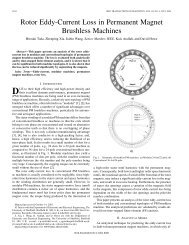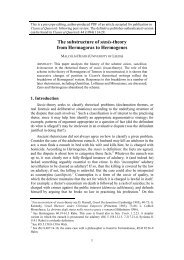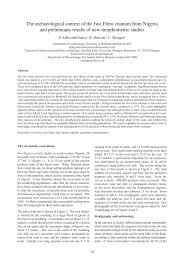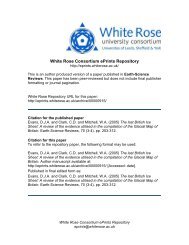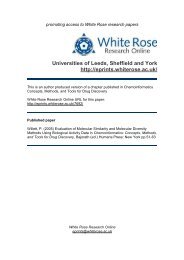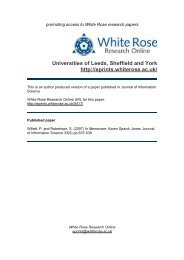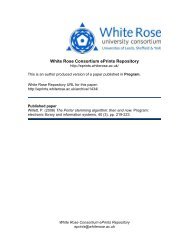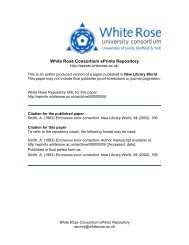The last British Ice Sheet: A review of the evidence utilised in the ...
The last British Ice Sheet: A review of the evidence utilised in the ...
The last British Ice Sheet: A review of the evidence utilised in the ...
Create successful ePaper yourself
Turn your PDF publications into a flip-book with our unique Google optimized e-Paper software.
3.4. Palaeo-icestreams<br />
Compared to o<strong>the</strong>r glaciated regions, very little research has been undertaken on <strong>the</strong> identification <strong>of</strong> ice<br />
stream impr<strong>in</strong>ts <strong>in</strong> <strong>the</strong> <strong>British</strong> glacial record, despite <strong>the</strong> availability <strong>of</strong> geomorphic criteria for <strong>the</strong><br />
identification <strong>of</strong> palaeo-ice streams (e.g. Stokes and Clark, 1999, 2001; Clark and Stokes, 2003). Based upon<br />
<strong>the</strong> <strong>evidence</strong> compiled <strong>in</strong> <strong>the</strong> Glacial Map <strong>of</strong> Brita<strong>in</strong> we suggest that <strong>the</strong> most compell<strong>in</strong>g <strong>evidence</strong> available<br />
so far for palaeo-ice streams occurs <strong>in</strong> <strong>the</strong> Vale <strong>of</strong> York, Vale <strong>of</strong> Eden, <strong>the</strong> Yorkshire Dales and <strong>the</strong> Tweed<br />
Valley, where subglacial l<strong>in</strong>eations document <strong>the</strong> impact <strong>of</strong> former trunk flow. Elsewhere, such as <strong>the</strong> Irish<br />
Sea bas<strong>in</strong> and Moray Firth, ice stream activity has been proposed based upon topographic constra<strong>in</strong>ts and<br />
sedimentological <strong>evidence</strong> (e.g. Merritt et al., 1995; Evans and O´ C<strong>of</strong>aigh, 2003). Although it is becom<strong>in</strong>g<br />
clear that several generations <strong>of</strong> ice flow l<strong>in</strong>eations exist and demonstrably cross-cut each o<strong>the</strong>r (e.g. Salt,<br />
2001; Smith, 2003), reconstructions <strong>of</strong> <strong>British</strong> <strong>Ice</strong> <strong>Sheet</strong> palaeo-ice flow dynamics are <strong>in</strong> <strong>the</strong>ir <strong>in</strong>fancy<br />
compared to o<strong>the</strong>r regions (e.g. Dyke and Morris, 1988; Dyke et al., 1992; Boulton and Clark, 1990a,b). We<br />
suggest that a systematic subglacial l<strong>in</strong>eation mapp<strong>in</strong>g programme is urgently required for Brita<strong>in</strong> <strong>in</strong> order to<br />
assess <strong>the</strong> dynamics <strong>of</strong> <strong>the</strong> former <strong>British</strong> <strong>Ice</strong> <strong>Sheet</strong> through <strong>the</strong> <strong>last</strong> glacial cycle.<br />
3.5. Surg<strong>in</strong>g activity<br />
Atta<strong>in</strong>ment <strong>of</strong> <strong>the</strong> maximum limits <strong>of</strong> <strong>the</strong> <strong>British</strong> <strong>Ice</strong> <strong>Sheet</strong> has been variously ascribed to surg<strong>in</strong>g activity.<br />
Eyles et al. (1994) employed <strong>the</strong> <strong>evidence</strong> <strong>of</strong> <strong>the</strong> Holderness hummocky mora<strong>in</strong>e and <strong>the</strong> fea<strong>the</strong>r edge <strong>of</strong><br />
Wi<strong>the</strong>rnsea Till <strong>in</strong> conjunction with Kelsey Hill gravels to support <strong>the</strong>ir reconstruction <strong>of</strong> a surg<strong>in</strong>g ice sheet<br />
marg<strong>in</strong> <strong>in</strong> East Yorkshire. <strong>The</strong> surg<strong>in</strong>g concept was first enterta<strong>in</strong>ed by Lamplugh (1911) and later supported<br />
by Boulton et al. (1977). Additionally, <strong>the</strong> low ice pr<strong>of</strong>ile <strong>of</strong> 1:750, as represented by <strong>the</strong> east coast drift limit<br />
from North Norfolk to <strong>the</strong> North Yorkshire Moors, was regarded as possible <strong>evidence</strong> <strong>of</strong> a surg<strong>in</strong>g lobe by<br />
Straw (1979). Some corroboration for surg<strong>in</strong>g <strong>in</strong> <strong>the</strong> North Sea comes from Carr’s (personal communication)<br />
suggestion that <strong>the</strong> pierc<strong>in</strong>g <strong>of</strong> <strong>the</strong> western edge <strong>of</strong> <strong>the</strong> Dogger Bank-Jutland mega-mora<strong>in</strong>e dur<strong>in</strong>g <strong>the</strong><br />
Diml<strong>in</strong>gton Stadial was due to a surge. <strong>The</strong> Irish Sea Till on <strong>the</strong> sou<strong>the</strong>rn Irish coast and <strong>the</strong> Scilly Till on <strong>the</strong><br />
north coast <strong>of</strong> St Mart<strong>in</strong>s <strong>in</strong> <strong>the</strong> Scilly Isles (Scourse, 1986, 1987, 1991a,b; O´ C<strong>of</strong>aigh and Evans, 2002a,b;<br />
Evans and O´ C<strong>of</strong>aigh, 2003; Hiemstra et al., <strong>in</strong> press) have been equated with a short-lived onshore flow <strong>of</strong><br />
<strong>the</strong> Irish Sea ice stream/ lobe, although <strong>the</strong> possibility <strong>of</strong> palaeo-surg<strong>in</strong>g is restricted to <strong>evidence</strong> <strong>of</strong> glacier<br />
marg<strong>in</strong>al thrust<strong>in</strong>g and hydr<strong>of</strong>racture fills produced by elevated groundwater pressures.<br />
Suggestions have also been made that surges characterized some marg<strong>in</strong>s <strong>of</strong> <strong>the</strong> ice sheet dur<strong>in</strong>g its<br />
recession. Evans and O´ C<strong>of</strong>aigh (2003) cite <strong>evidence</strong> <strong>of</strong> thrust mora<strong>in</strong>es on <strong>the</strong> eastern Irish and north Welsh<br />
coast as possible surge landforms. Long flut<strong>in</strong>gs term<strong>in</strong>at<strong>in</strong>g <strong>in</strong> glacitectonically thrust masses <strong>in</strong> Loch Ryan,<br />
SW Scotland, are cited by Salt (2001) as <strong>evidence</strong> <strong>of</strong> a late stage surge by Scottish ice.<br />
Despite <strong>the</strong>se proposals from various regions, no unequivocal geomorphic and sedimentary <strong>evidence</strong> for<br />
55




